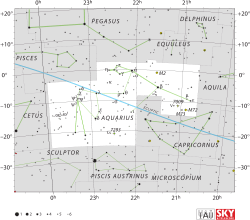Lambda Aquarii

Location of λ Aquarii (circled) | |
| Observation data Epoch J2000 Equinox J2000 | |
|---|---|
| Constellation | Aquarius |
| Right ascension | 22h 52m 36.87441s[1] |
| Declination | −07° 34′ 46.5542″[1] |
| Apparent magnitude (V) | 3.722[2] |
| Characteristics | |
| Spectral type | M2.5 IIIa Fe–1[3] |
| U−B color index | +1.721[2] |
| B−V color index | +1.641[2] |
| Variable type | Semiregular[4] |
| Astrometry | |
| Radial velocity (Rv) | −10.46 ± 0.53[5] km/s |
| Proper motion (μ) | RA: +17.02[1] mas/yr Dec.: +33.03[1] mas/yr |
| Parallax (π) | 8.47 ± 0.66[1] mas |
| Distance | 390 ± 30 ly (118 ± 9 pc) |
| Absolute magnitude (MV) | –1.5[6] |
| Details | |
| Mass | 3.6[7] M☉ |
| Temperature | 3,835[7] K |
| Metallicity [Fe/H] | –2.25[6] dex |
| Other designations | |
Lambda Aquarii (λ Aqr, λ Aquarii) is the Bayer designation for a star in the equatorial constellation of Aquarius. It has the obscure traditional names Hydor and Ekkhysis, from the ancient Greek ὕδωρ "water" and ἔκχυσις "outpouring". The apparent visual magnitude of this star is 3.722,[2] which is bright enough to be visible with the naked eye. It is roughly 390 light-years (120 pc) from Earth.[1]
In Chinese, 壘壁陣 (Lěi Bì Zhèn), meaning Line of Ramparts, refers to an asterism consisting of λ Aquarii, κ Capricorni, ε Capricorni, γ Capricorni, δ Capricorni, ι Aquarii, σ Aquarii, φ Aquarii, 27 Piscium, 29 Piscium, 33 Piscium and 30 Piscium.[8] Consequently, λ Aquarii itself is known as 壘壁陣七 (Lěi Bì Zhèn qī, English: the Seventh Star of Line of Ramparts.)[9]
Lambda Aquarii is a red giant star with a stellar classification of M2.5 III.[3] It is a semiregular variable star star with pulsation periods of 24.5, 32.0, and 49.5 days.[10] This star is on the asymptotic giant branch and is generating energy through the nuclear fusion of hydrogen and helium along concentric shells surrounding an inert core of carbon and oxygen.[11]
References
- ↑ 1.0 1.1 1.2 1.3 1.4 1.5 van Leeuwen, F. (November 2007), "Validation of the new Hipparcos reduction", Astronomy and Astrophysics 474 (2): 653–664, arXiv:0708.1752, Bibcode:2007A&A...474..653V, doi:10.1051/0004-6361:20078357.
- ↑ 2.0 2.1 2.2 2.3 Gutierrez-Moreno, Adelina et al. (1966), A System of photometric standards 1, Publicaciones Universidad de Chile, Department de Astronomy, pp. 1–17, Bibcode:1966PDAUC...1....1G.
- ↑ 3.0 3.1 Eggleton, P. P.; Tokovinin, A. A. (September 2008), "A catalogue of multiplicity among bright stellar systems", Monthly Notices of the Royal Astronomical Society 389 (2): 869–879, arXiv:0806.2878, Bibcode:2008MNRAS.389..869E, doi:10.1111/j.1365-2966.2008.13596.x.
- ↑ 4.0 4.1 "lam Aqr -- Pulsating variable Star", SIMBAD Astronomical Object Database (Centre de Données astronomiques de Strasbourg), retrieved 2012-07-01.
- ↑ Famaey, B. et al. (May 2009), "Spectroscopic binaries among Hipparcos M giants. I. Data, orbits, and intrinsic variations", Astronomy and Astrophysics 498 (2): 627–640, arXiv:0901.0934, Bibcode:2009A&A...498..627F, doi:10.1051/0004-6361/200810698.
- ↑ 6.0 6.1 Dupree, A. K.; Li, Timothy Q.; Smith, Graeme H. (October 2007), "Hubble Space Telescope Observations of Chromospheres in Metal-Deficient Field Giants", The Astronomical Journal 134 (4): 1348–1359, arXiv:0709.1709, Bibcode:2007AJ....134.1348D, doi:10.1086/520925.
- ↑ 7.0 7.1 Tsuji, Takashi (May 2007), "Isotopic abundances of Carbon and Oxygen in Oxygen-rich giant stars", in Kupka, F.; Roxburgh, I.; Chan, K., Convection in Astrophysics, Proceedings of IAU Symposium #239 held 21-25 August, 2006 in Prague, Czech Republic, pp. 307–310, arXiv:astro-ph/0610180, Bibcode:2007IAUS..239..307T, doi:10.1017/S1743921307000622.
- ↑ (Chinese) 中國星座神話, written by 陳久金. Published by 台灣書房出版有限公司, 2005, ISBN 978-986-7332-25-7.
- ↑ (Chinese) AEEA (Activities of Exhibition and Education in Astronomy) 天文教育資訊網 2006 年 7 月 7 日
- ↑ Tabur, V. et al. (December 2009), "Long-term photometry and periods for 261 nearby pulsating M giants", Monthly Notices of the Royal Astronomical Society 400 (4): 1945–1961, arXiv:0908.3228, Bibcode:2009MNRAS.400.1945T, doi:10.1111/j.1365-2966.2009.15588.x.
- ↑ Lebzelter, T.; Hron, J. (January 2008), "BRITE stars on the AGB", Communications in Asteroseismology 152: 178–181, Bibcode:2008CoAst.152..178L, doi:10.1553/cia152s178.
External links
| ||||||||||||||||||||||||||